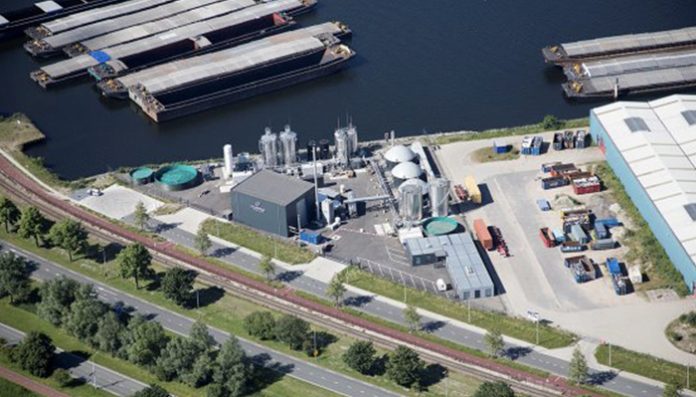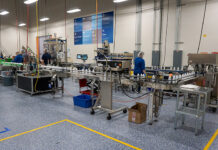When you arrive at the impressive production facility of ChainCraft in the port of Amsterdam, it’s clear that the company has passed the start-up phase and is now ready to serve the market. It all started at Wageningen UR, at the university laboratory where a fermentation technology was invented to convert organic residues into fatty acids.
Niels van Stralen, founder and director of Chaincraft explains: “In 2010 we got the opportunity to acquire the patent protecting the technology from the university. That was when Chaincraft was founded. After further developing the process on a lab-scale, we were able to scale up the process to a pilot plant in 2014 with the help of venture-capital investors. During 2015 we produced a few thousand kilos of fatty acids and we started testing the product in animal feed trials.” The product proved promising both in terms of animal health and performance. With these results, the company was ready to further scale up to a commercial demonstration factory and enter the animal feed market. In the current factory, 20,000 tons of organic residues can be processed into 2,000 tons of a C2-C8 fatty acid mixture.
Sustainable alternative
The company mainly produces Caproic acid (C6), which is known for its animal health-promoting properties. For instance, it improves the animal’s gut health and thus reduces the need for antibiotics. C6 acid is currently made from palm kernel oil. According to Van Stralen, organic residues are a significantly more sustainable source. “C6 availability in the market is still relatively poor, but it has very interesting and relevant properties for various types of livestock. Palm kernel oil only contains a tiny amount of C6 and it has to be imported from Malaysia and Indonesia. The organic residue streams we use come from local fruit and vegetable processing facilities, which are the major suppliers of supermarkets in the Netherlands. We’re actually the first company worldwide to be able to offer this product in large quantities that are obtained from a renewable, circular, and truly sustainable source.”
From organic residues to fatty acids
To produce the fatty acids the company uses mixed culture fermentation – a technology that is also used in fermentation plants for biogas production and is analogous to human food digestion. Van Stralen: “Bacteria break down the carbohydrates, proteins, and fats into short fatty acids (SCFAs). In a normal anaerobic digestion plant biogas (methane and CO2) are derived from these SCFAs. Basically, we ensure that the very last step doesn’t take place and we extend those short fatty acid chains to longer chains (MCFAs), making them more valuable.”
After the first fermentation, the remaining solid particles such as hard-to-degrade fibers and proteins are separated using a centrifuge. The remaining liquid substance, which contains the SCFAs, enters a second fermentation process, in which ethanol is added (this is obtained from beer brewers who make 0% alcohol beer). Van Stralen stresses that they only use naturally occurring bacteria in the fermentation process: “We don’t work with genetically modified bacteria.”
The product of the second fermentation is a liquid that still contains bacteria and fine particles. To get a pure, clean product several other steps are required. Ultrafiltration and reverse osmosis membranes are used to obtain a concentrated fatty acid solution. Next, dissolved molecules are filtered out by nano-filtration and the concentrated solution goes through an ammonium scrubber. Then there are 2 final steps: drying and evaporation.
Chain craft can produce the acids in powder or liquid form: a powder which is created by drying the product and a liquid product from the evaporator.
C6 and C4 fatty acids as feed additives
The final product contains, among other fatty acids, mainly C6 and C4. C4, butyric acid, is a well-known additive that contributes to a healthy gut; for instance, it improves gut morphology and stimulates the formation of tight junctions. The other main component is C6, Caproic acid, which is an organic acid that is not so well known in the feed industry, according to Jeroen van Dorp, Business Development Manager: “Caproici acid is a novel ingredient that is traditionally overlooked for research and use because of its low availability and high price, even though it has excellent antimicrobial properties.” C6 is mostly effective against gram-negative bacteria, such as salmonella and E. coli and it also combats viruses by enhancing RNA degradation. Van Dorp: “Bacteria are efficiently combatted as longer MCFAs (>C5) damage the microbes’ cell walls, after which the shorter MCFAs.
A bright future ahead
The company seems to have a bright future ahead. The next step will be to build a new factory, which will increase production by a factor of 10. Right now, the production of Chaincraft is being scaled up and it is expected to reach 100% utilization in 2021. According to Van Stralen and Van Dorp, they are negotiating with many interested parties from the feed industry. When there are sufficient commercial agreements, the company can further increase production via this new build full-scale facility. Although the company is currently only producing for the animal feed market, fatty acids can be used for many other applications as well, which presents further opportunities in the future. Van Stralen: “If, for example, we start making fatty acids for plasticizers, herbicides, and coatings, we can also use other lower-value residual flows, which creates new business opportunities. However, the animal feed industry is the first and most important market we are focusing on for our MCFAs.”
source: www.allaboutfeed.net









